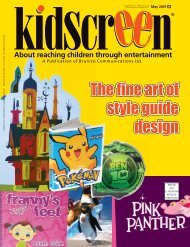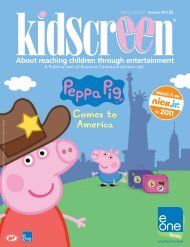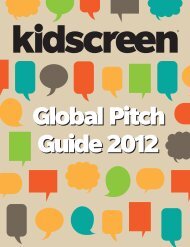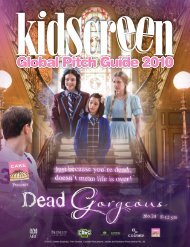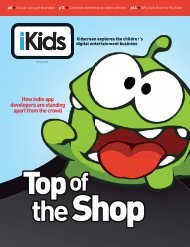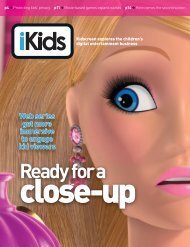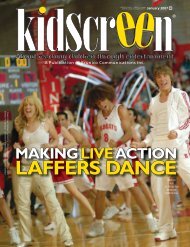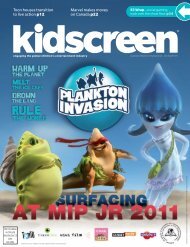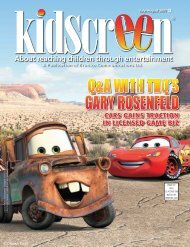rs ANIMATION SECIVRES CONTENTS - Kidscreen
rs ANIMATION SECIVRES CONTENTS - Kidscreen
rs ANIMATION SECIVRES CONTENTS - Kidscreen
Create successful ePaper yourself
Turn your PDF publications into a flip-book with our unique Google optimized e-Paper software.
20<br />
PROGRAMMING<br />
INNOVATION<br />
While the process of producing 2D has changed<br />
radically in the last decade, production houses<br />
still strive to maintain the look and feel of<br />
traditional hand-drawn animation via digital<br />
means. And kidcaste<strong>rs</strong> the world over remain<br />
more than happy to fi ll their airwaves with<br />
digitally produced content that mimics<br />
the decades-old artform. Not surprisingly,<br />
with 2D right now, it’s all about the software.<br />
Arguably, Montreal, Canada-based software developer Toon<br />
Boom has helped lead the 2D charge, developing multiple<br />
products that have made the production of 2D animation<br />
more cost-effective over time. While the software can be<br />
used to produce other styles of animation, including CGI,<br />
its hallmark product, Harmony, has become a predominant<br />
player in 2D animation production. With a client list of bluechippe<strong>rs</strong><br />
like Disney, Warner Bros. Unive<strong>rs</strong>al, Fox, Nelvana<br />
and Cartoon Network, Toon Boom’s software is currently<br />
employed in 122 different countries and the company has<br />
been recognized recently with a Primetime Emmy for its<br />
new Storyboard Pro software.<br />
Joan Vogelesang, president and CEO of Toon Boom Animation,<br />
says it’s her company’s goal to give produce<strong>rs</strong> the tools<br />
they need to tell a story in the most cost-effective manner.<br />
“Our software enables people to unleash their own creativity,”<br />
she says. “People were losing money by going in and out of<br />
different technologies, so a product like Harmony allows that<br />
money to be re-invested in the production.”<br />
In essence, Harmony is an umbrella software program that<br />
allows animato<strong>rs</strong> to utilize the digital advantage in their production.<br />
It contains features that allow production houses to<br />
compose animation, and most importantly, control and manage<br />
the workfl ow from start to fi nish. The suite includes tools<br />
that can easily manipulate textures and line widths, character<br />
shape and color, and integrate photos and 3D images. Both<br />
KIDSCREEN’S <strong>ANIMATION</strong> SERVICES ISSUE 2012<br />
Harmony and Storyboard Pro are largely responsible for the<br />
emerging paper-less environment of 2D animation studios.<br />
The savings from that innovation alone are noticeable to produce<strong>rs</strong>’<br />
bottom lines.<br />
The Storyboard Pro software allows studios to visualize<br />
concepts before going into production and easily integrate<br />
additional assets like photography to pitch concepts without<br />
a major cash outlay. “We have a powerful pipeline management<br />
system,” says Vogelesang. “As well, people can work<br />
from remote sites, the software can pull it all together, and we<br />
can re-use assets to cut time out of production.”<br />
Developing a library of animation that can be re-used and<br />
re-purposed is another tool that has expedited the entire animation<br />
process. “You can animate three different poses and<br />
the software will animate the in-between motions between<br />
the three,” says Vogelesang. “There are also texturing tools.<br />
It’s so deep, it’s amazing. You can really save a fortune by<br />
using it.”<br />
Heather Walker, head of development at Toronto, Canada’s<br />
Yowza Animation, agrees that using computer software is the<br />
only way to effectively deliver content in the current market.<br />
“It’s a function of time and cost” she says.<br />
When the studio was founded in 1996, the majority of its<br />
productions were hand-drawn, however things went fully digital<br />
about six yea<strong>rs</strong> ago. “Compute<strong>rs</strong> just became more costeffective<br />
and effi cient,” she says.








